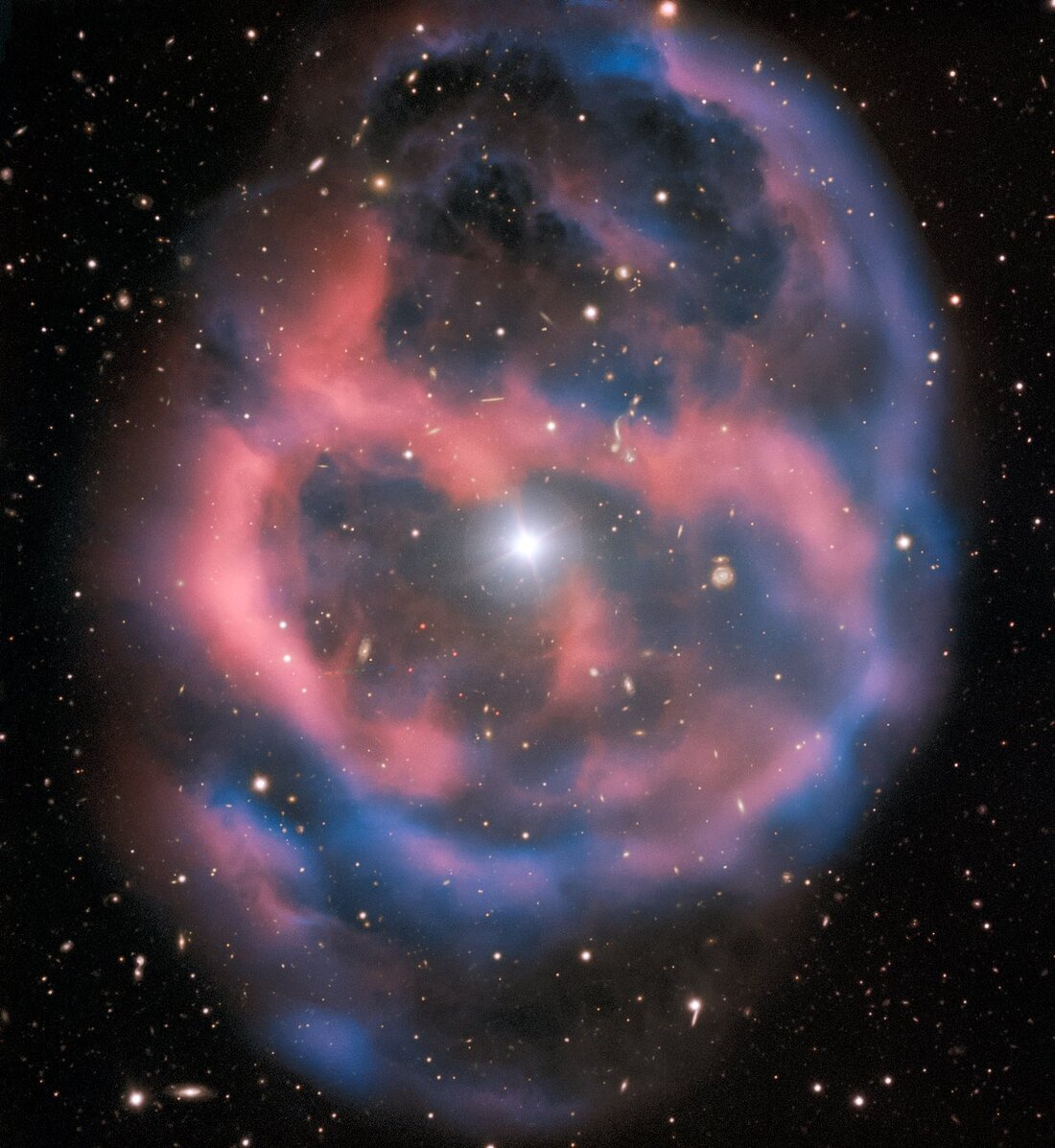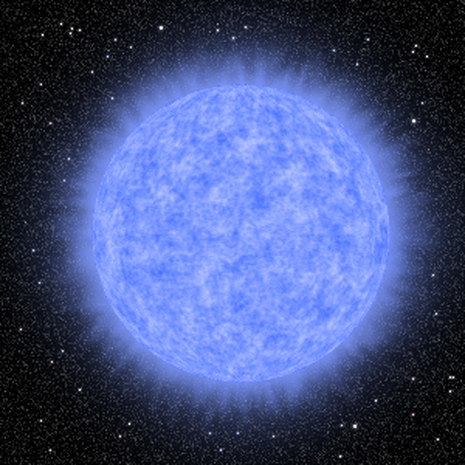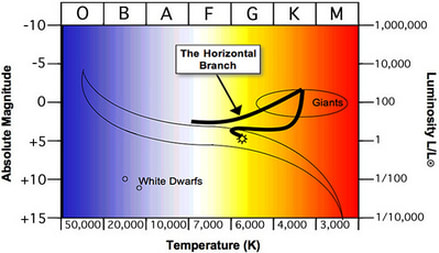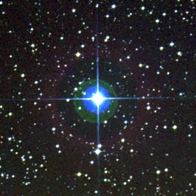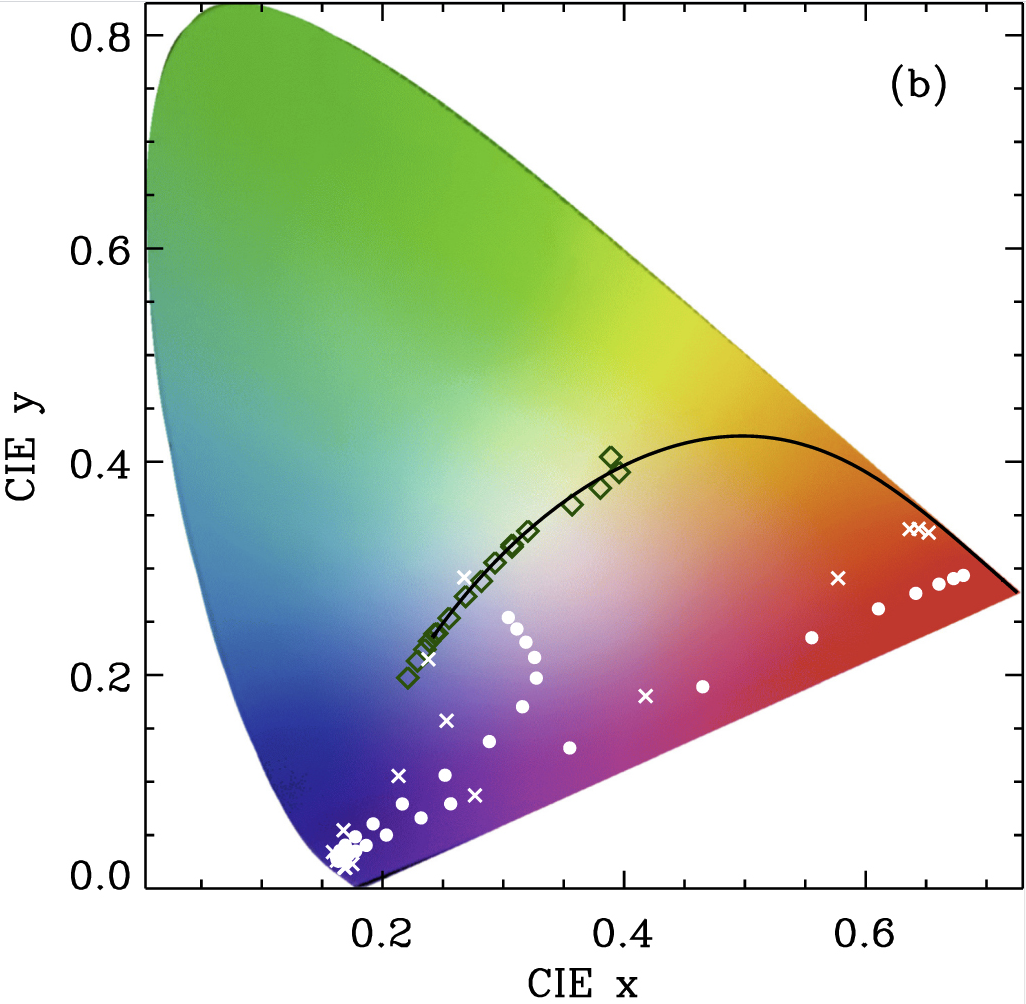This list is the result of an experiment I did in the spring of 2021 to try to visually detect the colors of the brightest, bluest stars I could find. After observing a number of carbon stars, which are among the visually reddest objects in the night sky, I started to wonder about the opposite end of the spectrum. But it turns out that there are very few stars that are blue enough, and bright enough, to convey a sense of intense, saturated color to the eye.
The list
For source material, I used the catalog of 118,200 stars generated from the European Space Agency's Hipparchos mission (1989-1993). I ran a query of the Hipparchos catalog via SIMBAD (ultimately, VizieR) asking for all stars brighter than 10th magnitude, and including basic data like V magnitude and B-V color. I set cuts at V brighter than 10th and B-V ≤ -0.20, which returned 228 stars. I sorted the list by B-V and found that the bluest stars were -0.30 ≤ B-V ≤ -0.34. I then set out to observe some of them. I checked this against the Tycho-2 catalog, and eventually I'll check it against Gaia.
The columns are:
1. Hipparchos catalog number.
2. A cutout image of the star from the blue plate of the Second Digitized Sky Survey.
3. Proper name for the star, if available.
4. SAO catalog number for the star.
5. HD catalog number for the star, if available.
6. Constellation in which the star appears.
7. Right ascension (epoch J2000.0).
8. Declination (epoch J2000.0).
9. V magnitude from SIMBAD.
10. B-V color from SIMBAD.
11. U-B color from SIMBAD.
12. Spectral type from SIMBAD.
1. Hipparchos catalog number.
2. A cutout image of the star from the blue plate of the Second Digitized Sky Survey.
3. Proper name for the star, if available.
4. SAO catalog number for the star.
5. HD catalog number for the star, if available.
6. Constellation in which the star appears.
7. Right ascension (epoch J2000.0).
8. Declination (epoch J2000.0).
9. V magnitude from SIMBAD.
10. B-V color from SIMBAD.
11. U-B color from SIMBAD.
12. Spectral type from SIMBAD.
| A | B | C | D | E | F | G | H | I | J | K | L | |
|---|---|---|---|---|---|---|---|---|---|---|---|---|
1 | HIP | DSS2 Cutout | Name | SAO | HD | Con | RA (J2000.0) | DEC (J2000.0) | V | B-V | U-B | SIMBAD spType |
2 | 40047 | -- | 6435 | -- | UMa | 08h 10m 49s | +74° 57′ 58″ | 9.47 | -0.34 | -1.23 | sdO5 | |
3 | 32602 | -- | 218207 | 49798 | Pup | 06h 48m 05s | -44° 18′ 58″ | 8.24 | -0.33 | -1.26 | sdO6 | |
4 | 43866 | -- | 76431 | 76431 | Hya | 08h 56m 11s | +01° 40′ 38″ | 9.17 | -0.30 | -- | B0V (BHB) | |
5 | 81145 | -- | 141250 | 149382 | Oph | 16h 34m 23s | -04° 00′ 52″ | 8.87 | -0.28 | -1.14 | sdB | |
6 | 27204 | μ Columbae | 196149 | 38666 | Col | 05h 46m 00s | -32° 18′ 23″ | 5.17 | -0.28 | -1.06 | O9.5V | |
7 | 33165 | EZ CMa | 172546 | 50896 | CMa | 06h 54m 13s | -23° 55′ 42″ | 6.91 | -0.28 | -0.89 | WN5-B | |
8 | 52849 | -- | 62257 | 93521 | LMi | 10h 48m 24s | +37° 34′ 13″ | 6.99 | -0.27 | -1.12 | O9.5IIInn | |
9 | 39540 | -- | 116308 | 66665 | CMi | 08h 04m 48s | +06° 11′ 10″ | 7.79 | -0.27 | -1.1 | B1V | |
10 | 39618 | -- | 153820 | 67072 | Pup | 08h 05m 46s | -16° 21′ 47″ | 9.68 | -0.27 | -- | B2III | |
11 | 9221 | -- | -- | -- | And | 01h 58m 33s | +38° 34′ 24″ | 9.89 | -0.27 | -- | sdOHe |
Note that the table is sorted in order of B-V color starting with the bluest object.
These are some of the types of stars that appear on the list:
These are some of the types of stars that appear on the list:
Hot subdwarfs
|
An ESO/Very Large Telescope image of the planetary nebula Abell 36, at whose center is ta hot O subdwarf star.
|
Subdwarfs are a group of stars whose luminosities are 1.5 to 2 magnitudes lower than that of Main Sequence stars of the same spectral type. On the Hertzsprung-Russell diagram, these stars lie below the Main Sequence, running parallel to it. However, their evolutionary histories are different than ordinary Main Sequence stars. In particular, so-called "hot" and "cool" subdwarfs, distinguished by their effective temperatures, are entirely different kinds of stars. The hot subdwarfs, whose effective temperatures are similar to O and B stars on the Main Sequence, appear to represent the late stages of some evolved stars. They result from situations where a red giant star loses its outer, hydrogen-rich layers before core helium fusion begins. This might arise in the context of a binary pair where the hydrogen envelope is lost due to mass transfer to the secondary star in the system. It has even been suggested that some B-type subdwarfs might result from the mergers of white dwarfs.
|
'Early' Main Sequence stars
|
Stars with spectral types ranging from O to B have surface temperatures in excess of 10,000 degrees, which appear very blue to the human eye. Spectral type roughly correlates with stellar mass, meaning that the so-called "early" stars in the Main Sequence fuse hydrogen in their cores rapidly. That makes them hotter -- and hence, bluer -- than 'later' Main Sequence stars like the Sun. But while the Sun will spend upward of 10 billion years quietly burning hydrogen, massive stars exhaust their core hydrogen supply much sooner. These 'live fast, die young' stars are usually found not far from where they are born, as there is little time for them to drift away from those locations before they evolve off the Main Sequence to mostly become supernovae. Not only are there relatively few of them in the Milky Way, but there are not many bright examples because massive stars aren't forming in our part of the galaxy right now.
One star on the list (HIP 43866) is a 'blue horizontal branch' star that is not on the Main Sequence. These objects are named for their distribution in the Hertzsprung-Russell diagram, which indicates nearly constant luminosity over a large range of effective temperatures. They are low-mass stars that have left the red giant phase after igniting helium fusion in their cores. They spend relatively little time in this phase; after burning helium for about 100 million years, enough carbon 'ash' left from this process accumulates in their cores that helium burning is limited to a shell surrounding the core. As they contract and heat up, hydrogen begins fusing again in a shell above the helium-burning shell, and the star progresses into the Asymptotic Giant Branch phase. Blue horizontal branch stars have their blue colors in part because they tend to have very low 'metallicity'; i.e., there are relatively few absorption lines in their spectra attributable to elements heavier than helium. Typically these 'metal' lines absorb a lot of blue light, but their weak absorption in this case lets more of the underlying blue light through. |
An artist rendering of the blue supergiant star Naos (ζ Puppis), one of the hottest, and most luminous, stars visible to the naked eye.
Hertzsprung-Russell diagram showing the Horizontal Branch along the evolutionary track of a low-mass star. Figure courtesy of the Swinburne University of Technology.
|
Wolf-Rayet stars
|
Digitized Sky Survey color composite image of EZ Canis Majoris
|
One of the bluest Hipparchos stars is HIP 33165, also known as the variable star EZ Canis Majoris. It is a Wolf-Rayet star, a rare type of evolved star whose spectra show little hydrogen, significant significant abundances of heavy elements, and very strong stellar winds.
These stars have left the Main Sequence and are fusing helium (or heavier elements) in their cores, while their winds have completely ejected their outer hydrogen envelopes. Given the much higher temperatures involved in fusing helium as compared to fusing hydrogen, and with no outer envelope to attenuate the additional radiation, Wolf-Rayet stars have effective temperatures ranging from 20,000 up to 200,000 degrees, making them the hottest stars known. In many cases, the abundant ultraviolet light emitted by these stars ionizes the material shed during mass loss from stellar winds, lighting it up. |
Observations of very blue stars
My observations were made with a small (20 cm, f/3.8) Newtonian telescope at low magnification (~60x). The combination of the small aperture and moderately light-polluted skies at my location motivated a V=+10 cutoff for targets. Stars much fainter than this yield little sensation of any color. I also tried defocusing the telescope slightly to see whether there was any effect on the perceived colors of the stars. Although limited in how far I could defocus before the image became unacceptably dim, I saw no obvious color shift.
Quoting from my observing notes, the bluest star of the lot (HIP 40047; V=+9.5; B−V=−0.34) was "distinctly" blue, "like a dark sky blue." It was "definitely not white."
The next bluest star (HIP 43866; V=+9.2; B-V = −0.30) was "not as saturated" as HIP 40047, but still "definitely bluish". By the time one drops somewhat below B−V = −0.27, the blue is just a suggestion and white is the predominant color.
Two stars in around 7th magnitude with comparable B-V (HIP 52849 and HIP 55051) looked a lot like bright B stars like Spica (B−V = −0.23), when comparing the fainter stars through the telescope eyepiece with the brighter star seen unaided.
To me, stars like Spica, Rigel (B−V = −0.03), Vega and Sirius (both B−V = 0.0) all have a slight bluish tinge atop what is generally a colorless white. I think of all of these stars as a "steely blue-white", even though their B−V colors range over almost 0.3 dex.
Quoting from my observing notes, the bluest star of the lot (HIP 40047; V=+9.5; B−V=−0.34) was "distinctly" blue, "like a dark sky blue." It was "definitely not white."
The next bluest star (HIP 43866; V=+9.2; B-V = −0.30) was "not as saturated" as HIP 40047, but still "definitely bluish". By the time one drops somewhat below B−V = −0.27, the blue is just a suggestion and white is the predominant color.
Two stars in around 7th magnitude with comparable B-V (HIP 52849 and HIP 55051) looked a lot like bright B stars like Spica (B−V = −0.23), when comparing the fainter stars through the telescope eyepiece with the brighter star seen unaided.
To me, stars like Spica, Rigel (B−V = −0.03), Vega and Sirius (both B−V = 0.0) all have a slight bluish tinge atop what is generally a colorless white. I think of all of these stars as a "steely blue-white", even though their B−V colors range over almost 0.3 dex.
These are my observing notes for stars on the list above plus ζ Puppis, in order of increasingly positive B−V (i.e., most blue to least blue):
HIP 40047 (V=+9.5; B−V=−0.34) — Faint. Distinctly blue, like a dark sky blue. Definitely not white.
HIP 32602 (V=+8.2; B−V=−0.33) -- Seen very low in the sky under poor seeing conditions. Color was barely perceptible, but clearly bluer than Rigel. Maybe about like the Orion Belt stars. Just the faintest tinge of blue on white. (Note: At the time of this observation, HIP 32602 was at 4.3 airmasses. Presumably its apparent color was 'de-blued' by significant atmospheric extinction.)
HIP 43866 (V=+9.2; B−V=−0.30) — Faint. Not as saturated as HIP 40047, but definitely bluish.
HIP 81145 (V=+8.9; B−V=−0.28) — It's definitely bluer than the Big Dipper stars. The color compares favorably with Spica; maybe just a shade darker, but very close. Obviously bluer than Vega. [N.B.: The B−V color of Vega is defined to be 0, and the Dipper stars, excluding the bluest and reddest, average to B−V = +0.02.]
HIP 27204 = μ Columbae (V=+5.2; B−V=−0.28) — Just the slightest touch bluer than Rigel. Clearly bluer than Sirius. [N.B.: The B−V colors of Rigel and Sirius are −0.03 and 0.0, respectively.]
HIP 33165 (V=+6.9; B−V=−0.28) — Color compares favorably with Rigel. Clearly bluer than Sirius.
HIP 52849 (V=+7.0; B−V=−0.27) — Brighter than HIP 40047 and 43866. Not as blue, but definitely more blue than, e.g., Vega and Spica.
HIP 39540: (V=+7.8; B−V=−0.27) — Easily the bluest star in the field, and distinctly bluer than Sirius. Color seems most like Spica.
HIP 39618: (V=+9.7; B−V=−0.27) — Color is a dark, dull grayish blue. Its color is very distinct in comparison to the orange 8th magnitude star a few arcminutes from it. [N.B.: this star is HD 67118. It is a V=+8.2 star classified as a K5 giant.] Definitely gets (apparently) brighter with averted vision but the orange star does not.
ζ Puppis: (V=+2.3; B−V=−0.27) — Just a touch bluer than Sirius. Clearly bluer than Rigel.
HIP 55051 (V=+7.4; B−V=−0.24) — Seems a touch bluer than Spica or the Big Dipper stars. Maybe a touch bluer than Spica. [N.B.: The B−V of Spica is −0.23, so this is a pretty close match.]
It would be interesting to repeat this observation through a large (≥1 m) aperture to find out whether the increased light-gathering capacity has any effect on the perceived colors of the same stars. (Thanks to Dr. David Galadí Enríquez of Calar Alto Observatory for this suggestion!)
HIP 40047 (V=+9.5; B−V=−0.34) — Faint. Distinctly blue, like a dark sky blue. Definitely not white.
HIP 32602 (V=+8.2; B−V=−0.33) -- Seen very low in the sky under poor seeing conditions. Color was barely perceptible, but clearly bluer than Rigel. Maybe about like the Orion Belt stars. Just the faintest tinge of blue on white. (Note: At the time of this observation, HIP 32602 was at 4.3 airmasses. Presumably its apparent color was 'de-blued' by significant atmospheric extinction.)
HIP 43866 (V=+9.2; B−V=−0.30) — Faint. Not as saturated as HIP 40047, but definitely bluish.
HIP 81145 (V=+8.9; B−V=−0.28) — It's definitely bluer than the Big Dipper stars. The color compares favorably with Spica; maybe just a shade darker, but very close. Obviously bluer than Vega. [N.B.: The B−V color of Vega is defined to be 0, and the Dipper stars, excluding the bluest and reddest, average to B−V = +0.02.]
HIP 27204 = μ Columbae (V=+5.2; B−V=−0.28) — Just the slightest touch bluer than Rigel. Clearly bluer than Sirius. [N.B.: The B−V colors of Rigel and Sirius are −0.03 and 0.0, respectively.]
HIP 33165 (V=+6.9; B−V=−0.28) — Color compares favorably with Rigel. Clearly bluer than Sirius.
HIP 52849 (V=+7.0; B−V=−0.27) — Brighter than HIP 40047 and 43866. Not as blue, but definitely more blue than, e.g., Vega and Spica.
HIP 39540: (V=+7.8; B−V=−0.27) — Easily the bluest star in the field, and distinctly bluer than Sirius. Color seems most like Spica.
HIP 39618: (V=+9.7; B−V=−0.27) — Color is a dark, dull grayish blue. Its color is very distinct in comparison to the orange 8th magnitude star a few arcminutes from it. [N.B.: this star is HD 67118. It is a V=+8.2 star classified as a K5 giant.] Definitely gets (apparently) brighter with averted vision but the orange star does not.
ζ Puppis: (V=+2.3; B−V=−0.27) — Just a touch bluer than Sirius. Clearly bluer than Rigel.
HIP 55051 (V=+7.4; B−V=−0.24) — Seems a touch bluer than Spica or the Big Dipper stars. Maybe a touch bluer than Spica. [N.B.: The B−V of Spica is −0.23, so this is a pretty close match.]
It would be interesting to repeat this observation through a large (≥1 m) aperture to find out whether the increased light-gathering capacity has any effect on the perceived colors of the same stars. (Thanks to Dr. David Galadí Enríquez of Calar Alto Observatory for this suggestion!)
Cranmer paper
|
A recent paper by Stephen Cranmer ('Brown Dwarfs are Violet: A New Calculation of Human-eye Colors of Main-sequence Stars and Substellar Objects', Research Notes of the AAS, Volume 5, Number 9, p. 201) "presents a collection of objective (CIE coordinate) and subjective (RGB triple) colors for main-sequence stars and brown dwarfs, as well as links to related codes and tables."
The author notes that "using the proposed conversion from CIE to RGB colors, O and B stars are bluer than equivalent blackbodies because of Paschen continuum absorption." The analysis finds that most Main Sequence stars (green diamonds) lie pretty close to the blackbody locus (black line in the CIE x-y chromaticity diagram), except for the hottest stars and brown dwarfs, which the author argues "may appear violet to human eyes." "Also shown are how the ... estimated RGB colors vary with Teff". (below) The visual match with HIP 40047 (Teff ~ 50,000 K) is pretty good. |
CIE (x,y) chromaticity diagram showing blackbody colors (black curve) and computed star/brown-dwarf colors (symbols). Fig. 1b in Cranmer (2021).
|
Fig. 1e in Cranmer (2021) showing interpolated RGB colors of various stars by effective temperature. "Stars with Teff > 10,000 K appear blue, but the hottest stars are slightly bluer than even the Teff → ∞ end of the Planck blackbody locus."
